At the heart of Yangon (Rangoon) is its bustling downtown and riverfront, where businesses, shopping, river trade and many hotels are centred.
Designed in the mid-1800s by Lieutenant Alexander Fraser, who also designed Singapore, the streets are laid out on a grid pattern – with numbers increasing from west to east, making navigation fairly simple (but bear in mind the occasional road has a name rather than a number). The downtown and riverfront area is walkable, although you should always bear in mind the heat of the day.
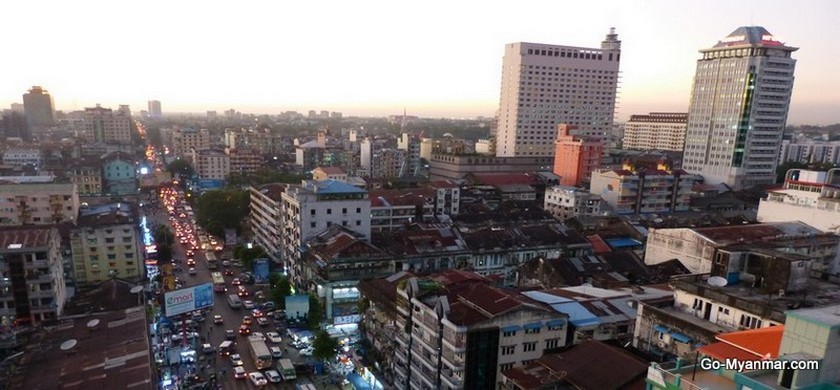
Downtown
At the centre of downtown is the crossroads of Sule Pagoda Road and Mahabandoola Road. This is the location of the ancient Sule Pagoda (situated in the middle of a large roundabout) and Mahabandoola Garden, immediately to its south east. Sule Pagoda acts as a good reference point to get your bearings downtown, and the garden is a haven from the noise of the streets; at its centre is Yangon’s Independence Monument, a large white obelisk.
Second World War bombing brought much destruction to downtown Yangon, so not all of its original colonial architecture is intact – but plenty still remains, making it unique amongst large cities in Southeast Asia. As you wander around, there are fascinating buildings to discover on almost every street; some restored, some in desperate need of repair.
Take a look at our YouTube video of Mahabandoola Garden Park from the south.
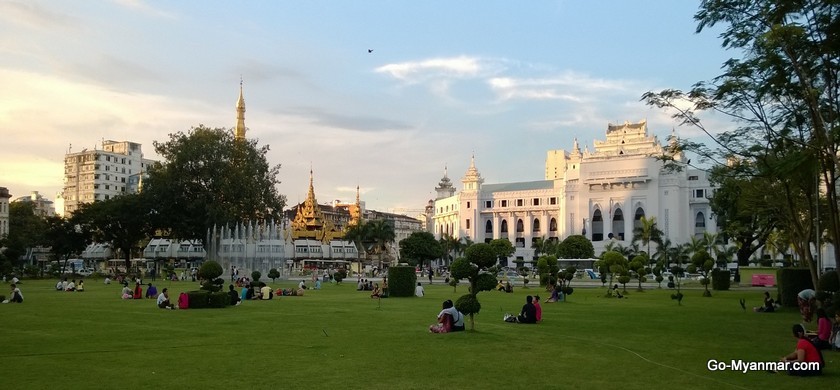
Some of the downtown architectural highlights include:
- City Hall, just east of Sule Pagoda on Mahabandoola Road. Opened in 1936, this building was designed by local architect U Tin, and fuses colonial and oriental design elements.
- The High Court, 89-133 Pansodan Road, east of Mahabandoola Garden. Completed in 1911, built from red brick and featuring a big clock tower, this building hosted the highest appeals court in Myanmar until it was moved to Nay Pyi Taw in 2005.
- The Pegu Club, sitting just north of the downtown grid, it is one of Yangon’s most richly atmospheric buildings. Once frequented by George Orwell and Rudyard Kipling, this impressive teak structure contains large halls, wide corriders, and parquet floors. Recently renovated, the building is not open to the public and available only for private events.
- The Telegraph Office (Myanma Posts and Communications), 125-133 Pansodan Road, corner of Mahabandoola Road. Built in 1911 by Scottish architect John Begg, this is another classic colonial red brick building.
For a wider selection of photos, go to our downtown Flickr photo album.
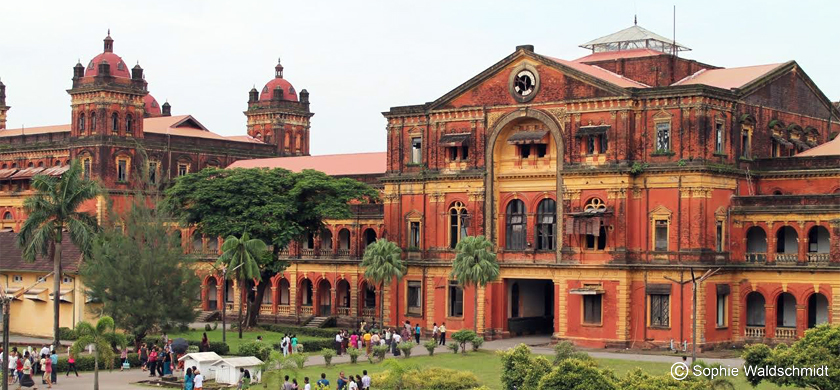
The Secretariat
Sitting on an impressive 6.5 hectares, the Secretariat is one of Yangon's largest and most iconic remanents of British colonialism. Completed in 1905, the Secretariat was the administrative seat of colonial Burma and after independence, hosted the nation's first independent parliament. Yet, it is perhaps best known as the location of independence hero Aung San's assassination in 1947. For next 60 years, the building stood empty, its iron banisters and creaky staircases collecting only dust.
After over a half-century of political turmoil and being fenced off to the public, in early 2018 the red-brick landmark finally reopened its doors for a lengthy series of restorations and renovations. Once completed, this grand space will contain an office complex, a museum and a public hall for hosting exhibitions, performances, seminars, and educational initiatives.
Also referred to as the 'Minister's Building', the Secretariat occupies the entire block between Anawratha and Mahabandoola Roads and Thein Phyu and Bo Aung Kyaw Roads at the heart of downtown.
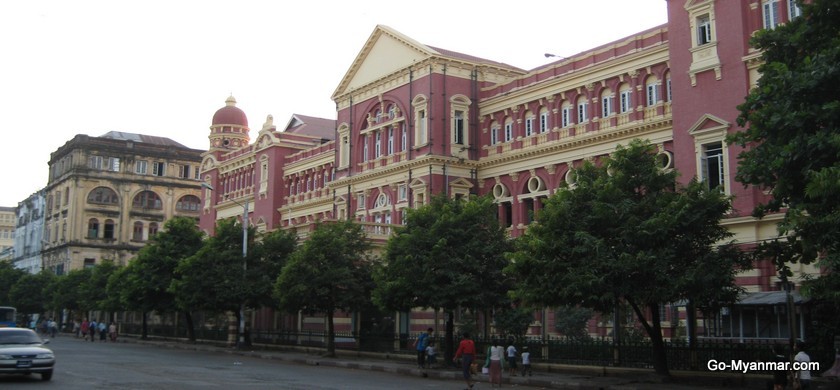
The buildings described above only scratch the surface of what Yangon has to offer – the Strand riverfront also features a delightful and varied array of colonial-era buildings (see below) and a full list of structures on Yangon’s City Heritage List can be found here.
In 2012, a 50-year moratorium was imposed on the demolition of buildings in Yangon that are over 50 years old, and the Yangon Heritage Trust was founded by prominent Myanmar historian Thant Myint-U to help ensure the survival and considered restoration of these beautiful and historically significant buildings.
We offer a variety of tours of Myanmar that include the sights of downtown Yangon - find out more here. You can also find Yangon city tours and activities that can be booked via this website (on the right hand side bar further up this page).
Yangon Central Station and the Circular Railway
The original Yangon Central railway station was destroyed during the Second World War but the current building, completed in 1954, remains an interesting example of Burmese post-colonial architecture, comprising classical elements. The station serves as a link to other parts of the country and is also the starting point for the Yangon Circular Railway, a 46-kilometre, three-hour commuter loop that also serves as a fascinating slice of local life, with lots of smiles, waving and singing with locals. Sit in an open doorway to get the best view out of the train, and hold on for a sometimes bumpy ride!
The station can be found just to the north of central downtown. Circular railway tickets cost $1 and you will need your passport. Trains leave roughly every hour between 6am and 2pm; check at the station for precise times.
For other things to see and do in downtown Yangon, go to markets and religious monuments. For eating and drinking, go here.
The riverfront
Yangon’s riverfront, along which runs Strand Road (known as Kanna Lan in Burmese), is a hive of trading activity and hosts one of the greatest concentration of architectural gems in the city; buildings include the Yangon Region Court, Custom House, the famous Strand Hotel, and the Myanma Port Authority. Walking this historic stretch at sunset is the most beautiful time of day to take in these colonial treasures.
For a wider selection of photos, go to our riverfront Flickr photo album.
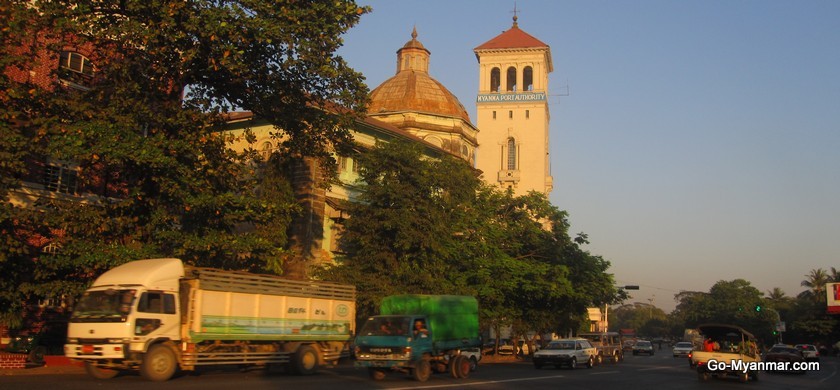
Across the road from these buildings are the busy Yangon river docks, where boats both large and small come to load and unload their goods, destined for the city’s masses.
There are a number of cruises that leave from Botataung (east end of downtown) and Wardan (west end of downtown) jetties for a relaxing few hours on the Yangon River. And from Pansodan Ferry Terminal you can take a boat across to Dala, where you can see local markets and take in much slower pace of life on the delta; many locals commute across the river to Yangon, because prices are lower – and people poorer – in Dala. Public ferries leave every 30 minutes; foreigners are not allowed to take small private boats.







